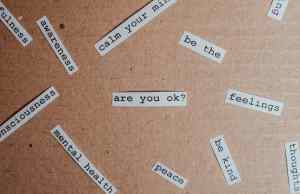Many people across the world struggle with suicidal thoughts and feelings every day. However, when those suicidal thoughts result in an intent act, they cross over into suicidality. Suicidality can feel very isolating and makes it seem as though life is only pain and darkness.
These feelings are not easy to discuss, but by bringing them to light, this allows them to be acknowledged and treated. This also presents an opportunity to help those struggling feel less alone. Crisis hotlines like 988, the Suicide and Crisis Lifeline, offer assistance 24 hours a day for anyone who is struggling.

What Is Suicidality? Suicidality Definition
Suicidality is defined by the American Psychological Association (APA) as “the risk of suicide, usually indicated by suicidal ideation or intent to commit suicide, especially as evident in the presence of a well-elaborated plan.”
What Does it Mean to Have Suicidal Tendencies?
Essentially, suicidality describes the state of thinking of or intending to die by suicide, or the propensity of someone to have suicidal thoughts or attempt suicide. There are varying levels of suicidality which can be gauged by its current presentation in an individual, such as their current level of intent (how serious are they about taking their life?), ideation (severity and frequency of suicidal thoughts), and planning (is there a plan and has one been carried out?). Past suicidal ideation or attempts and behaviors or gestures are also factors that can be included in an assessment.
Suicidal tendencies can make life feel extremely isolating and painful. These challenges can feel heavy and overwhelming constantly, making one feel exhausted, which makes it very difficult to see a way to relieve that pain and stress. Though it might feel hopeless, seeking help and talking about these problems, especially with a mental health professional, is the best way to start healing issues with suicidality.
Symptoms of Suicidality
No one struggling with suicidality will act exactly the same. Each person’s challenges and circumstances are unique, so they will each shoulder the weight in a different way. However, there are some common signs that can point to suicidality, including:
- Isolation or withdrawal from social contact
- Expressing emotions like emptiness, hopelessness, or feeling trapped
- Talking about suicide (i.e. saying “I’m going to kill myself,” “I don’t want to be here anymore,” or “I wish I were dead”)
- Thinking frequently on death, dying, or violence
- Extreme emotional highs and lows
- Obtaining a means to take their life
- Changes in personality, becoming increasingly anxious, irritable, or agitated
- Risky, self-destructive behavior (such as reckless driving)
- Behaving oddly, like there’s no future (saying goodbye to people like they won’t see them again, giving away belongings for no foreseeable reason)
If you’re experiencing symptoms of suicidality, consider reaching out to someone close to you and talking about how you’re feeling, even though it will feel difficult. Bringing your issues out into the open, even if it’s just with one person, can help them feel a bit more manageable and help you feel less alone. It’s also important to seek help from mental health services. Though talking to someone close to you is an excellent first step, a therapist or psychiatrist will be most equipped to help you through what you’re facing and give you the support and treatment you need.
If you’re worried about someone close to you and think they may be struggling with suicidality, try approaching them and letting them know you’re there for them. You don’t have to come out and address your concerns right away, but making sure they know that you care about them and providing a non-judgmental space for them to come as they are can help them feel comfortable enough to approach you in the future about their problems.
Suicidality Risk Factors
Though there are many risk factors that exist most everywhere, risk factors for suicidality can differ by region. Some of the most prevalent factors include:
- Isolation
- Loss of any kind (personal, financial, social)
- Medical conditions or chronic pain
- General stress (life issues like finances, job, etc.)
- Stigma around mental health and mental health issue
- Past suicide attempts or history of self-harm
- Depression
- Low socio-economic status
- Relationship problems
- Access to methods to carry out suicide
- Substance abuse
However, despite there being many common risk factors and signs of suicidality, there are many people who do not display them overtly that still take their lives. In fact, according to the Centers for Disease Control (CDC), over 50% of people that die by suicide had no known or diagnosed mental health conditions at time of their death.
Are Suicidal Thoughts a Sign of Depression?
Suicidal thoughts and behaviors can certainly be a sign that someone is depressed. However, suicidal thoughts can point to other conditions besides depression, too.
When considering what might be causing suicidal thoughts, the intensity of the thoughts needs to be assessed to provide context: Do they have a plan? How detailed or lethal is the plan in question? How often do they consider taking their life? What’s happening in their life? And so on. The best course of action is to contact a mental health professional about the symptoms and discuss whether they may be a result from depression, life circumstances, or another mental condition.
However, if the situation is more dire and more immediate help is needed, call the 988 Suicide and Crisis Lifeline. There, you can speak to people ready and able to help you with what you’re feeling and any mental health emergency you may be experiencing. Help is always available, and you can speak to someone 24 hours a day.
The staff there is not only there to listen to you, but they can also provide help by creating a low-level coping plan with you, so that until you can speak with a steady therapist or medical professional, you have something to help you manage what you’re feeling.
Can You Call 911 for Suicidal Thoughts?
You can call 911 when experiencing suicidal thoughts, but there are other options that may be better suited to handle situations dealing with suicidal ideations or behavior. As stated above, the first step in deciding what to do is to assess your thoughts and level of distress: How seriously are you thinking about harming yourself?
Reasons to call 911 immediately would be if you do not have a means of transportation to a hospital for evaluation, you’ve already engaged in a form of harm, have attempted suicide, or are unsure that you can be safe while driving yourself to the hospital. If you are not sure you can make it to the hospital without further harm to yourself, calling 911 for medical attention is the best choice.
If you are very mentally distressed, you should call 988 to reach the Suicide and Crisis Lifeline. They can help you deal with what you’re facing and put you in touch with mental health services equipped to respond to mental health crises and people in mental health distress.
The difference between calling 911 versus 988 is expertise. Unlike the professionals on the line with 988, the ones answering when you call 911 are not necessarily trained to respond to mental health crises, and are best for if you are in a state of medical emergency. However, if you do decide or need to call 911, request a crisis intervention team (CIT) officer.
Should I Call 911 if My Friend Is Suicidal?
Similarly to having suicidal thoughts, you can call 911 if your friend is suicidal, but it’s not necessarily advised as a first option. Assess your friend’s level of risk by asking them questions about how they are feeling and whether they are in immediate danger of committing suicide. One way to gauge the intensity of someone’s suicidal ideation is to ask them to list, on a scale from 1 (I am not going to kill myself) to 10 (Suicide is imminent), where they are at emotionally.
If they are struggling but seem receptive to help, call 988 and have them speak to the person on the line about their situation. If they are in immediate physical danger, though, it may be best to call 911 and get help through them to intervene.
Talking to someone you love that is suicidal can be very scary, intimidating, and uncomfortable. You may not always know what to say or how best to help them, especially if you have never experienced suicidality before yourself. However, talking about what’s happening is the best way to start solving the problem, and you could help simply by letting them know that you’re a safe person to talk to and that you’re willing to sit with them in all that they’re experiencing.
Is There a Suicidality Assessment?
Yes, there is a suicidality assessment, one that’s usually performed by mental health professionals. It involves taking all factors of the person’s circumstances and evaluating how those factors are contributing to the person’s suicidal symptoms:
- Socio-demographic data, such as age, gender, race, culture/ethnicity, immigration status and experiences, languages, religion, and a number of other identifiers. For example, trans suicidality statistics are much higher than many other queer and non-queer groups, so being trans would be a considerable risk factor.
- Current presentation of suicidality, which takes into account the person’s ideation (frequency and intensity of suicidal thoughts), planning (what is it/have they tried it?), lethality of the plan, and intent (how likely is it that they will carry out the plan?).
- Psychiatric illnesses, with specific interest in mood disorders such as depressive disorders and anxiety disorders. They will also have their mental status assessed for diagnosis.
- Medical history, including inpatient and outpatient treatment, ER visits, and treatment compliance.
- Psychosocial situation, as pertaining to factors like social support, loneliness, marriage status, bereavement, work environment, and other social elements.
- Individual strengths and vulnerabilities, specifically suicide risk factors and protective factors. Risk factors for suicidality would include behaviors or circumstances that put someone at risk for suicidality, such as impulsivity, substance use, employment issues, or hopelessness. Protective factors would be behaviors that work against suicidality, like receiving effective mental care, positive personal connections, religion, or restriction to very lethal means of suicide.
By examining each of these categories and how much sway they hold in someone’s life, a mental health professional can assess whether someone is struggling with suicidality and what the contributing factors to their condition are.
Suicidality Training Practices
If you want training and experience dealing with suicidality, there are trainings that you can take to help prepare you to assist someone with suicidal ideation. The Substance Abuse and Mental Health Services Administration (SAMHSA) has an Applied Suicide Intervention Skills Training (ASIST) workshop available for healthcare professionals as well as anyone over the age of 16.
There are also certificate courses offered by Mental Health First Aid for those that are not medical professionals but would like some level of training.
Suicidality Intervention Techniques for Approaching Someone with Suicidal Thoughts
The first thing to understand when approaching someone with suicidality is that there are no “right words.” A great way to try and understand them is to kindly ask them what they want from you. This way, you can approach them the way they want to be approached, already helping to release some tension.
Being non-judgmental, empathetic, and understanding are also ways you can try to connect with them. It’s important to remember that, while this is a very tense, nerve-racking situation to be in, your help needs to be centered around what they need, not your fear. This means that helping them might look like providing a safe space for them to exist with you as they are, understanding the place of darkness, despair, and hopelessness that they are in.
That being said, when someone you love is experiencing suicidality, it can be hard to separate your well-being from theirs. As much as you may want to help, in the end, they are on their own journey, and it’s something they will have to handle themselves.
You can also be a better support system and resource for them as they heal by making sure to fill yourself up as you give your energy to them. Performing self-care, giving yourself rest, and making sure to do things you enjoy are ways that you can keep yourself from getting too burnt out during this stressful, scary time.
What Are Good Next Steps for Dealing with Suicidality?
Once you’ve assessed the intensity of their suicidality, professional help is the best step to take. If the situation is approaching crisis levels, 988 might be the best resource to put them in contact with.
If you’re confident the situation is less time-sensitive (for example, they’ve just had suicidal thoughts at this point but have not made a plan), sit down with them and get them connected to mental health services. A professional will be the most equipped to handle such a high-stakes mental health situation. Getting connected to one yourself to help you process any stress and pressure you may be feeling is also a good idea.
You can also contact your local Community Services Board (CSB), since they have 24/7 crisis numbers and teams available to assist people. Search for your local CSB online to find more info and get immediate help.
Mental health professionals have the best tools, support, and knowledge to help anyone struggling with suicidality, so if you or a loved one are considering suicide, contact 988 or go to your nearest emergency room right away to speak to someone about what’s happening and get the help that you need.













